New-Look Imports: From Green Bottles to Premium Cans
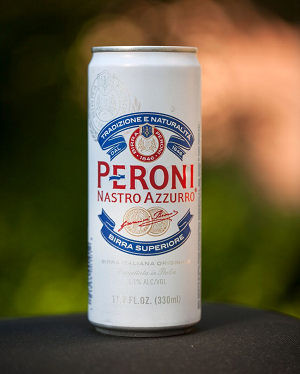
(Photo by Jeff Quinn)
Peroni Nastro Azzurro had quite the summer last year.
The pale lager was spotted at rooftop pools and patios at luxury hotels on South Beach and in Beverly Hills, and was snapped by paparazzi at The House of Peroni event during New York Fashion Week.
Those photos showed the beer not in its iconic green bottle, but rather in a new slim can more appropriate to these outdoor occasions. The white 11.2-ounce cans were available in only a few select test markets in 2016 before being launched in additional locations throughout the United States this year.
But there was one location where those stylish new cans were absent: Italy.
While Peroni does have cans in its home country, the brewery considers Nastro Azzurro a premium product. As was the case in the United States before craft brewers popularized them, cans are seen as down-market in most of Europe and reserved for the economy segment of beer.
“I think it’s going to need something like the craft movement to help that happen,” says David Schmid, who represents Peroni and other brands as the director of prestige imports at Tenth and Blake Beer Co., the craft and import division of MillerCoors.
Consumer perception aside, another reason cans have yet to catch on throughout Europe is that most countries there have strong returnable bottle markets, wherein consumers can return glass bottles for a deposit.
While slow to move in their native countries, breweries have begun exporting canned offerings to the States, where there’s no such stigma against putting a premium product in cans. And though cans are en vogue across America, breweries across Europe are not always going lightly into the package.
Making the Case for Cans

(Photo by Jeff Quinn)
Finding an American saison in cans isn’t a tough challenge. But if you’re looking for a saison from Belgium, you’re apt to find it packaged in large, 750 mL bottles, often adorned with a cork and a cage.
That’s how Brasserie St-Feuillien packaged its saison until 2013, when Artisanal Imports—the brewery’s U.S. importer—proposed putting the beer in cans, citing the popularity of the package in the craft segment. Lanny Hoff, the senior vice president of Artisanal Imports, believes it was the first Belgian saison in a can.
“The sheer beer geekery of it was awesome for us,” says Hoff, who persuaded brewery owner Dominique Friart to bring the beer into cans. “It took a little bit of explaining to her and her team that cans were no longer viewed as the down-market, cheap package that they were at the time in Belgium.”
There are cans in Belgium, of course, and they’re not only reserved for what some might see as “economy” or “down-market” beers. Cans of Rodenbach Classic can be found at concerts and other outdoor occasions, despite the Flanders red ale not being an obvious choice for the package.
“But in its home geography of West Flanders, Rodenbach is an alternative to pilsners,” notes David van Wees, founder of Latis Imports, which imports the brewery’s beers to the U.S. “People drink the Classic Rodenbach as one would a pilsner here. It’s a very refreshing beer.”
Whether cans of Rodenbach Classic are distributed to the States depends partly on the success of Fruitage, a 4.2% ABV blend of young and foeder-aged Rodenbach, with cherries and elderberries. The bright, slender 8.5-ounce cans are a departure for the brand, which packages many of its beers in large bottles. Still, the company didn’t hesitate to introduce a new beer in a new format earlier this year.
“The interesting thing about Rodenbach is it is of course an import from Belgium, but it somehow has an appreciation or an ability to transcend craft or import,” says Van Wees. “I think the ardent specialty craft drinker would respect that Rodenbach has this ability to have this dual personality between being an ultra specialty craft and being imported.”

(Photo by Jeff Quinn)
Brouwerij Van Honsebrouck started canning Kasteel Rouge for sale in its native Belgium in 2014, but just this year introduced the cans to the American audience. The cherry-liqueur-infused quad is now available in four-packs of 16-ounce cans, some of which are packaged in small coolers. In addition to a strong start in the United States, the new format is also doing well in Russia and France, according to brewery sales manager Marc Schrauwen.
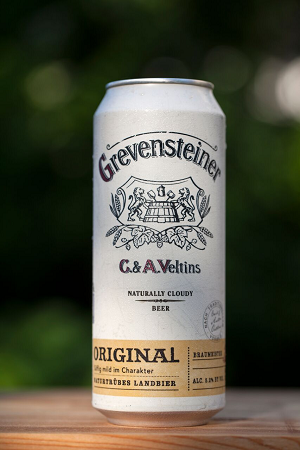
(Photo by Jeff Quinn)
After a successful first year of sales for St-Feuillien Saison, Hoff was able to point to its success as a case study for other brands. Just this year, Artisanal Imports helped introduce Germany’s Pfungstädter Weizen Radler and Grevensteiner in cans. The latter, a kellerbier from Brauerei C. & A. Veltins, had previously been exported to the U.S. in short “steinie” bottles. Despite the new cans being a drastic departure from those distinct bottles, Hoff says it wasn’t a tough sell to persuade Veltins to put the beer in cans.
“That was a really easy thing to do,” says Hoff. “The German guys understood that there’s no particular reason for cans to be inferior from a quality perspective. That was easy to make the case to them.”
It doesn’t hurt, says Hoff, that cans weigh far less than bottles and stack better than glass. For Artisanal Imports, that means it can ship more beer for less money.
“Logistics is a big cost, and cans are a lot cheaper to ship,” Hoff says. “I think the numbers are anywhere between 25 and 30 percent cheaper. And that’s not nothing, man. That’s quite a lot.”
A Changing Global Perspective
When Sierra Nevada Brewing Co. started packaging its beers in cans, brewers across Europe took note, says Hoff. For many, seeing an industry leader embracing cans helped erase the idea that the package was reserved only for lower-quality beers.
“When we can point to well-regarded breweries that are known globally, that helps a lot,” says Hoff. “When Sierra Nevada started doing cans, that was something that everybody in Europe noticed. The brewers are admitting that they can see a global influence on packaging and can say to themselves, ‘You know, the can actually kind of makes sense.’”
It’s easy to make the case for Pfungstädter Weizen Radler in cans as well, given the success Austria’s Stiegl has had with its own canned radlers. Stiegl bottles its popular grapefruit radler, but cans of this beer (as well as a new lemon version) have taken off in the U.S. and Canada.
“We were in the right time and the right place with that product,” says Claudia Nussbaumer, product manager export for Stiegl. “We created a category. The flavor was well-received in the states and people loved it. I think the can was just a door opener in retail.”
While Stiegl doesn’t share specific sales numbers, Nussbaumer says that the cans constitute the vast majority of the company’s total radler sales. But in the brewery’s native Austria, Nussbaumer says, cans in general are more of a niche offering given the country’s bottle deposit system.
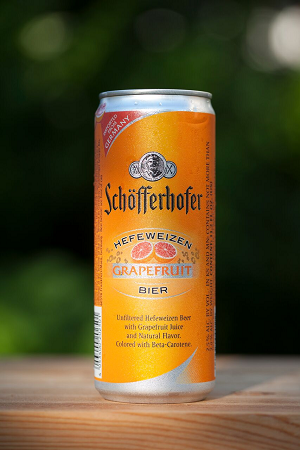
(Photo by Jeff Quinn)
Like Stiegl, Binding-Brauerei AG in Frankfurt, Germany has had recent success exporting cans of radler—in this case the brewery’s hefeweizen mixed with grapefruit juice. While cans haven’t caught on in their native Germany, where they’re not seen as a premium product, Schöfferhofer recently moved the Hefeweizen Grapefruit into four-packs of 16.9-ounce cans as well as 12-packs of 11.2-ounce “slim” cans for export to the U.S.
In Germany, many drinkers are familiar with the brewery’s standard hefeweizen. Rather than exporting the unadulterated version or new flavors to the U.S., however, the brewery is focusing solely on the grapefruit version.
While that beer has been distributed to the U.S. in clear bottles and 16.9-ounce cans, the brand recently added 12-packs of 11.2-ounce cans (the same “slim” cans used by Peroni).
“We saw the success of the big can, but wanted to introduce something new,” says Armin Buehler, head of marketing for Radeberger Gruppe USA. “We introduced our 12-pack this year. It’s doing extremely well. It’s a liquid that really fits well in this format.”
The Decade of the Can
Mexican-style lagers, like the aforementioned radlers, are well-suited to cans. Easy drinking and lower in alcohol, these beers are ideal for summer sipping and outdoor occasions—which has long been a hallmark in how the beers are advertised. Considering there’s no stigma surrounding cans in Mexico as there is in many European countries, why has it taken so long for Mexican brands to move into cans?
TRENDING: Mexican-Style Lagers
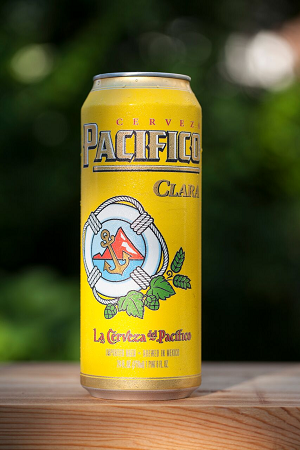
(Photo by Jeff Quinn)
European breweries like Brasserie St-Feuillien carefully thought about the ramifications of putting its beers into cans. It wasn’t much of a consideration for Pacifico. The brand introduced 24-ounce cans in February of 2016, and earlier this year launched its first ever 12-ounce cans.
“We really didn’t have any trepidation over moving to cans,” says Matt Escalante, senior brand marketing director for Pacifico. While Escalante notes that some consumers prefer bottles for high-end beers, others are content to drink premium beers in cans when the occasion is right.
But if you’re a brewery like Corona, whose marketing and branding is so tied to a distinctive bottle, investing heavily in cans might give you pause. Few are the people who haven’t seen the iconic bottle featuring prominently in the brewery’s commercials, waves lapping the shore in the background.
“Corona’s clear bottle is iconic to the brand, and we will always be a bottle-forward brand,” says John Alvarado, vice president of brand marketing at Constellation Brands. “There’s so much equity and so much consumer love in our bottle, when we decided to do the major relaunch in the cans, we said, ‘OK this has to be on top of that.’”
Corona has been putting its beer in cans for years, but according to Alvarado “no one really knew about them.” Two years ago, after much research into consumer preferences, Corona relaunched its can business by redesigning the cans to more prominently feature the typography and branding drinkers associate with the bottles.
They promoted the beer at several music festivals, and this year the can even got a commercial of its own. The commercial shows a can of Corona Extra as it slips from a six-pack and rolls from person to person before finding its way to the beach.
Since the relaunch, Corona’s can business has doubled, according to Alvarado. And while it’s not a phrase they use in any consumer-facing marketing, employees in-house refer to these efforts as just part of the “decade of the can.”
“It’s an easy way internally for us to wrap our heads around it,” says Alvarado. “We have big ambitions. We intend to continue, first and foremost, to drive our Corona bottle business, but then also over the next decade we will continue to grow our can business in a big way.”
Breweries across the globe will look to do the same by exporting more cans to the United States, where the stigma that once surrounded cans has all but disappeared, thanks to their popularity among craft brewers. In their home markets, though, cans can still be a tough sell.
You won’t find cans of St-Feuillien’s saison in Belgium, or packaged Grevensteiner’s cans in Germany. But as is the case with beer styles, says Hoff, packaging continues to evolve.
“That kind of evolution, to me, is one of the most fascinating things about the beer business,” Hoff says. “The same thing is happening with packaging. It’s happening in Europe very slowly, but they’re starting to come around.”
Daniel Hartis is the editor of All About Beer Magazine.
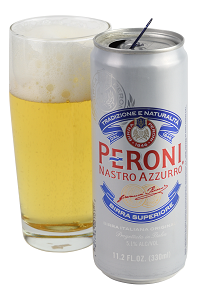
Peroni Nastro Azzurro
ABV: 5.1% | Pale LagerTasting Notes: The slim-can format feels right for this one. Well chilled, this remains a simple, crispy lager on the sweet side, but there are balancing elements of zesty carbonation and subtle mineral bitterness keeping this refreshing. Honey, toastiness, a hint of white grapes--all the basics. –Ken Weaver
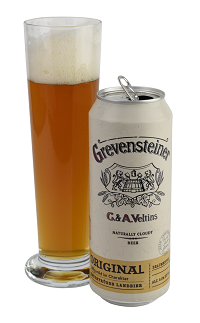
Grevensteiner
ABV: 5.2% | KellerbierTasting Notes: Yeast and clove aromas rise from the glass, calling to mind a hefeweizen--but the similarities end there. The cloudy amber beer offers up flavors of honey-slathered toast, with the lightest touch of figs. It boasts substantial body, and there’s a nuttiness on the finish--like the skin of a peanut--followed up by a trace of pipe tobacco. It’s a German lager and not a Belgian ale, and yet at its heart the beer’s rustic and warm nature calls to mind Bière de Garde. –Daniel Hartis

Kasteel Rouge
ABV: 8% | Quad Blended w/ Cherry LiqueurTasting Notes: While ruby edges only hint at the fruit used, the aroma isn’t so subtle. Sweet syrup stops just short of cloying, thanks to a pleasant tartness keeping everything in check. Behind it all is a little bubblegum, dark bread and a warmth that makes this one a fine after-dinner choice. –DH

Leave a Reply